View in other NatureServe Network Field Guides
NatureServe
Montana
Utah
Wyoming
Idaho
Wisconsin
British Columbia
South Carolina
Yukon
California
New York
Old World Swallowtail - Papilio machaon
Native Species
Global Rank:
G5
State Rank:
S4
Agency Status
USFWS:
USFS:
BLM:
External Links
General Description
Not all authorities agree on the specific status of members in the Papilio machaon group (see Scott 1986; McCorkle and Hammond 1988; Sperling and Harrison 1994; Guppy and Shepard 2001; Pyle 2002; Warren 2005), with some treating P. m. bairdii and P. m. oregonius as full species instead of subspecies. Given the taxonomic uncertainty and instability, this account probably includes information pertaining to more than one taxon, possibly more than one species.
[From Ferris and Brown 1981; Scott 1986; Opler and Wright 1999; Glassberg 2001; Pyle 2002] Forewing 4.0-4.5 cm. Variable in color, with black or yellow forms, tailed. Tegulae (thorax at wing base) yellow, abdomen mostly yellow in yellow forms, abdomen black with two or three rows of yellow spots along sides in black forms. Uppersurface usually with broad yellow median bands (narrower in black forms), blue postmedian hindwing spots, orange eyespot at anal angle of hindwing with pupil not centered (off-center and touching inner margin or oblong black patch at lower margin). Undersurface with yellow bands tinges with orange.
Phenology
One flight, mostly June to early July in the north (Alaska, northern British Columbia), two or three flights farther south, May to September (Scott 1986). Mainly May to June, mid-July to September (Glassberg 2001). May to August in Rocky Mountain states (Ferris and Brown 1981), early May to late August in Colorado (Scott and Scott 1978), mid-March to mid-October in Oregon and Washington (Pyle 2002), two or three flights mid-March through September in Oregon (Warren 2005), one flight June and July in British Columbia (Guppy and Shepard 2001).
Diagnostic Characteristics
Best determined by a combination of single long tail, thorax shoulders usually yellow or gold, abdomen mostly yellow with black stripe in yellow forms, abdomen black with two or three rows of yellow spots along sides in black forms, orange eyespot at anal angle of hindwing with pupil not centered (off-center and touching inner margin or oblong black patch at lower margin).
Species Range
Montana Range
Range Descriptions
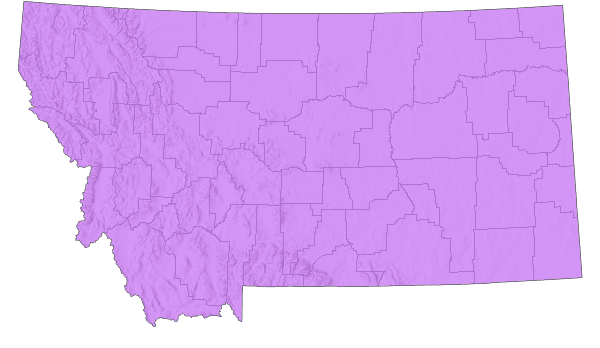
 Native
Native
Range Comments
Holarctic. In North America, Alaska south through Canada and western US to Arizona, southern California, southern New Mexico, east in Canada to western Quebec, in US to western Dakotas, western Nebraska, northwestern Kansas (Scott 1986; Opler and Wright 1999; Glassberg 2001); usually below 2438 m elevation in Rocky Mountain states (Ferris and Brown 1981), 1402 m to 2926 m elevation (rare above 2438 m) in central Colorado (Scott and Scott 1978), 26 m to at least 1951 m elevation in Oregon (Warren 2005). In Montana, reported across the state on both sides of continental divide from at least 32 counties (Kohler 1980; Stanford and Opler 1993; FLMNH Lepidopterists' Society database), to at least 1829 m elevation. Rare to uncommon (Glassberg 2001).
Observations in Montana Natural Heritage Program Database
Number of Observations: 4
(Click on the following maps and charts to see full sized version)
Map Help and Descriptions
Relative Density
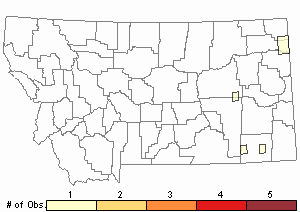
Recency
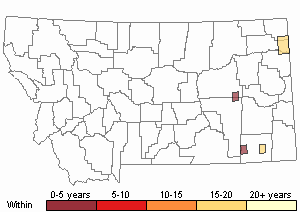
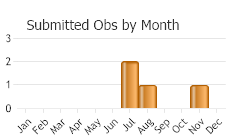
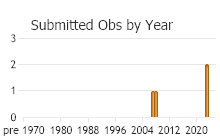
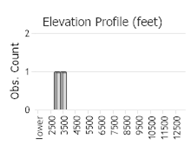 (Observations spanning multiple months or years are excluded from time charts)
(Observations spanning multiple months or years are excluded from time charts)
Migration
Non-migratory, although somewhat migratory in Europe. Males can fly several km to reach hilltops and ridgetops for courtship (Scott 1986).
Habitat
Open woodland, aspen, sagebrush steppe, prairie, tundra, arid canyons, river valleys, arid hills (Scott 1986; Opler and Wright 1999; Glassberg 2001; Pyle 2002). Habitat in Montana not described but probably similar. In Greater Yellowstone Ecosystem, reported from semi-arid mountains (Debinski and Pritchard 2002).
Food Habits
Larval food plants primarily Artemisia (multiple species, but A. dracunculus in our region), also Heracleum, Petasites, and Zizia. In lab, feed on members of the Apiaceae Daucus, Foeniculum, and Pastinaca (Emmel and Emmel 1963; Newcomer 1964; Ferris and Brown 1981; Scott 1986, 1992; Warren 2005; James and Nunnallee 2011). Adults feed on flower nectar (including Asclepias, Balsamorhiza, Carduus, Castilleja, Cirsium, Cleome, Liatris, Medicago, Petunia, Phlox, Rosa, Rudbeckia, Verbena, Zinnea) and mud (Newcomer 1964; Pyle 2002; Scott 2014).
Reproductive Characteristics
Females lay eggs singly on host plant (Scott 1986, 1992; James and Nunnallee 2011). Eggs hatch in about 6-7 days (depending on temperature), develop from L1 instar to L5 instar and pupae in about 21-35 days (depending on Temperature), adults eclosing (emerge) from pupae in same year about 10-15 days, otherwise overwinter at least 9 months (possibly more than one winter) as pupae (Newcomer 1964; Scott 1979; James and Nunnallee 2011). Larvae feed on host plant leaves, rest on stems or among leaves, build no nests, wander for a day or two as L5 instar before pupating on host plant stem (Newcomer 1964; Scott 1986; James and Nunnallee 2011). Males patrol and perch throughout the day, often on hilltops and ridge crests, searching for passing females (Scott 1975b, 1986; Guppy and Shepard 2001; James and Nunnallee 2011).
Stewardship Responsibility
References
- Literature Cited AboveLegend:
 View Online Publication
View Online Publication Debinski, D.M. and J.A. Pritchard. 2002. A field guide to the butterflies of the Greater Yellowstone Ecosystem. Lanham, MD: Roberts Rinehart Publishers. 107 p.
Debinski, D.M. and J.A. Pritchard. 2002. A field guide to the butterflies of the Greater Yellowstone Ecosystem. Lanham, MD: Roberts Rinehart Publishers. 107 p. Emmel, J.F. and T.C. Emmel. 1963. Larval food-plant records for six western papilios. Journal of Research on the Lepidoptera 1: 191-193.
Emmel, J.F. and T.C. Emmel. 1963. Larval food-plant records for six western papilios. Journal of Research on the Lepidoptera 1: 191-193. Ferris, C.D. and F.M. Brown (eds). 1981. Butterflies of the Rocky Mountains. Univ. of Oklahoma Press. Norman. 442 pp.
Ferris, C.D. and F.M. Brown (eds). 1981. Butterflies of the Rocky Mountains. Univ. of Oklahoma Press. Norman. 442 pp. Glassberg, J. 2001. Butterflies through Binoculars: A Field Guide to the Butterflies of Western North America. Oxford University Press.
Glassberg, J. 2001. Butterflies through Binoculars: A Field Guide to the Butterflies of Western North America. Oxford University Press. Guppy, C.S. and J.H. Shepard. 2001. Butterflies of British Columbia: including western Alberta, southern Yukon, the Alaska Panhandle, Washington, northern Oregon, northern Idaho, northwestern Montana. UBC Press (Vancouver, BC) and Royal British Columbia Museum (Victoria, BC). 414 pp.
Guppy, C.S. and J.H. Shepard. 2001. Butterflies of British Columbia: including western Alberta, southern Yukon, the Alaska Panhandle, Washington, northern Oregon, northern Idaho, northwestern Montana. UBC Press (Vancouver, BC) and Royal British Columbia Museum (Victoria, BC). 414 pp. James, D.G. and D. Nunnallee. 2011. Life histories of Cascadia butterflies. Corvallis, OR: Oregon State University Press. 447 p.
James, D.G. and D. Nunnallee. 2011. Life histories of Cascadia butterflies. Corvallis, OR: Oregon State University Press. 447 p. Kohler, S. 1980. Checklist of Montana Butterflies (Rhopalocera). Journal of the Lepidopterists' Society 34(1): 1-19.
Kohler, S. 1980. Checklist of Montana Butterflies (Rhopalocera). Journal of the Lepidopterists' Society 34(1): 1-19. McCorkle, D.V. and P.C. Hammond. 1988. Genetic experiments with calverleyi-like mutation isolated from Papilio bairdi oregonius (Papilionidae). Journal of Research on the Lepidoptera 27:186-191.
McCorkle, D.V. and P.C. Hammond. 1988. Genetic experiments with calverleyi-like mutation isolated from Papilio bairdi oregonius (Papilionidae). Journal of Research on the Lepidoptera 27:186-191. Newcomer, E.J. 1964. Life histories of Papilio indra and P. oregonius. Journal of Research on the Lepidoptera 3:49-54.
Newcomer, E.J. 1964. Life histories of Papilio indra and P. oregonius. Journal of Research on the Lepidoptera 3:49-54. Opler, P.A. and A.B. Wright. 1999. A field guide to western butterflies. Second edition. Peterson Field Guides. Houghton Mifflin Company, Boston, Massachusetts. 540 pp.
Opler, P.A. and A.B. Wright. 1999. A field guide to western butterflies. Second edition. Peterson Field Guides. Houghton Mifflin Company, Boston, Massachusetts. 540 pp. Pyle, R.M. 2002. The butterflies of Cascadia: a field guide to all the species of Washington, Oregon, and surrounding territories. Seattle Audubon Society, Seattle, Washington. 420 pp.
Pyle, R.M. 2002. The butterflies of Cascadia: a field guide to all the species of Washington, Oregon, and surrounding territories. Seattle Audubon Society, Seattle, Washington. 420 pp. Scott, J.A. 1975b. Mate-locating behavior of western North American butterflies. Journal of Research on the Lepidoptera 14:1-40.
Scott, J.A. 1975b. Mate-locating behavior of western North American butterflies. Journal of Research on the Lepidoptera 14:1-40. Scott, J.A. 1979. Hibernal diapause of North American Papilionoidea and Hesperioidea. Journal of Research on the Lepidoptera 18(3): 171-200.
Scott, J.A. 1979. Hibernal diapause of North American Papilionoidea and Hesperioidea. Journal of Research on the Lepidoptera 18(3): 171-200. Scott, J.A. 1986. The butterflies of North America: a natural history and field guide. Stanford University Press, Stanford, California.
Scott, J.A. 1986. The butterflies of North America: a natural history and field guide. Stanford University Press, Stanford, California. Scott, J.A. 1992. Hostplant records for butterflies and skippers (mostly from Colorado) 1959-1992, with new life histories and notes on oviposition, immatures, and ecology. Papilio new series #6. 185 p.
Scott, J.A. 1992. Hostplant records for butterflies and skippers (mostly from Colorado) 1959-1992, with new life histories and notes on oviposition, immatures, and ecology. Papilio new series #6. 185 p. Scott, J.A. 2014. Lepidoptera of North America 13. Flower visitation by Colorado butterflies (40,615 records) with a review of the literature on pollination of Colorado plants and butterfly attraction (Lepidoptera: Hersperioidea and Papilionoidea). Contributions of the C.P. Gillette Museum of Arthopod Diversity. Fort Collins, CO: Colorado State University. 190 p.
Scott, J.A. 2014. Lepidoptera of North America 13. Flower visitation by Colorado butterflies (40,615 records) with a review of the literature on pollination of Colorado plants and butterfly attraction (Lepidoptera: Hersperioidea and Papilionoidea). Contributions of the C.P. Gillette Museum of Arthopod Diversity. Fort Collins, CO: Colorado State University. 190 p. Scott, J.A. and G.R. Scott. 1978. Ecology and distribution of the butterflies of southern central Colorado. Journal of Research on the Lepidoptera 17(2): 73-128.
Scott, J.A. and G.R. Scott. 1978. Ecology and distribution of the butterflies of southern central Colorado. Journal of Research on the Lepidoptera 17(2): 73-128. Sperling, F.A.H. and R.G. Harrison. 1994. Mitochondrial DNA variation within and between species of the Papilio machaon group of swallowtail butterflies. Evolution 48(2): 408-422.
Sperling, F.A.H. and R.G. Harrison. 1994. Mitochondrial DNA variation within and between species of the Papilio machaon group of swallowtail butterflies. Evolution 48(2): 408-422. Stanford, R.E. and P.A. Opler. 1993. Atlas of western USA butterflies: including adjacent parts of Canada and Mexico. Unpubl. Report. Denver and Fort Collins, Colorado 275 pp.
Stanford, R.E. and P.A. Opler. 1993. Atlas of western USA butterflies: including adjacent parts of Canada and Mexico. Unpubl. Report. Denver and Fort Collins, Colorado 275 pp. Warren, A.D. 2005. Lepidoptera of North America 6: Butterflies of Oregon, their taxonomy, distribution, and biology. Contributions of the C. P. Gillette Museum of Arthropod Diversity, Colorado State University. Fort Collins, Colorado. 406 pp.
Warren, A.D. 2005. Lepidoptera of North America 6: Butterflies of Oregon, their taxonomy, distribution, and biology. Contributions of the C. P. Gillette Museum of Arthropod Diversity, Colorado State University. Fort Collins, Colorado. 406 pp.
- Additional ReferencesLegend:
 View Online Publication
View Online Publication
Do you know of a citation we're missing? Allen, T.J., J.P. Brock, and J. Glassberg. 2005. Caterpillars in the field and garden: a field guide to the butterfly caterpillars of North America. Oxford University Press.
Allen, T.J., J.P. Brock, and J. Glassberg. 2005. Caterpillars in the field and garden: a field guide to the butterfly caterpillars of North America. Oxford University Press. Brock, J.P. and K. Kaufman. 2003. Kaufman Field Guide to Butterflies of North America. Houghton Mifflin Company, New York, NY 284 pp.
Brock, J.P. and K. Kaufman. 2003. Kaufman Field Guide to Butterflies of North America. Houghton Mifflin Company, New York, NY 284 pp. Caruthers, J.C., and D. Debinski. 2006. Montane meadow butterfly species distributions in the Greater Yellowstone Ecosystem. University of Wyoming National Park Service Research Center Annual Report, 2006. Vol. 30, Art. 14. 85-96.
Caruthers, J.C., and D. Debinski. 2006. Montane meadow butterfly species distributions in the Greater Yellowstone Ecosystem. University of Wyoming National Park Service Research Center Annual Report, 2006. Vol. 30, Art. 14. 85-96. Forister, M.L., E.M. Grames, C.A. Halsch, K.J. Burls, C.F. Carroll, K.L. Bell, J.P. Jahner, et al. 2023. Assessing risk for butterflies in the context of climate change, demographic uncertainty, and heterogeneous data sources. Ecological Monographs 93(3):e1584. https://doi.org/10.1002/ecm.1584
Forister, M.L., E.M. Grames, C.A. Halsch, K.J. Burls, C.F. Carroll, K.L. Bell, J.P. Jahner, et al. 2023. Assessing risk for butterflies in the context of climate change, demographic uncertainty, and heterogeneous data sources. Ecological Monographs 93(3):e1584. https://doi.org/10.1002/ecm.1584 Layberry, R.A., P.W. Hall, and J.D. LaFontaine. 1998. The Butterflies of Canada. University of Toronto Press. 280 pp. + color plates.
Layberry, R.A., P.W. Hall, and J.D. LaFontaine. 1998. The Butterflies of Canada. University of Toronto Press. 280 pp. + color plates.
- Web Search Engines for Articles on "Old World Swallowtail"
- Additional Sources of Information Related to "Insects"





